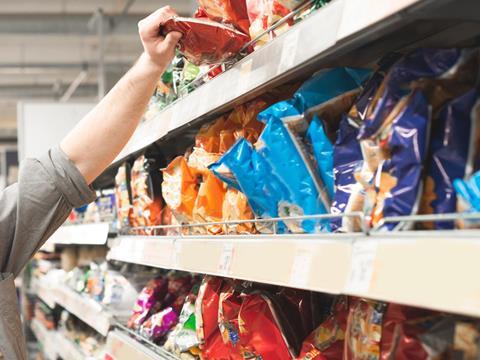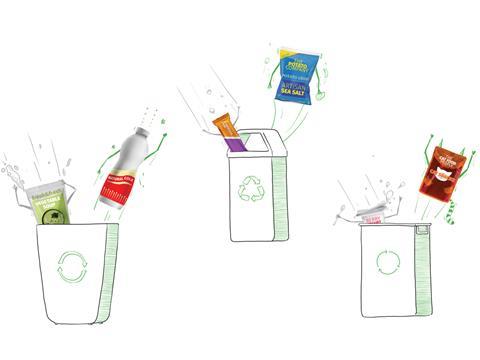
A number of technological developments are opening possibilities for more renewable, recyclable, and circular packaging, several of them involving coating resins. Jacqueline Revet, global marketing manager at DSM and Juan Guerrero, industry manager for printing and packaging at DSM, explain how bio-based resins, low-toxicity crosslinkers, and mono-material solutions can enable greater recycling possibilities.
The pressing need for sustainable packaging
The world is facing several urgent environmental challenges, including natural resource scarcity, climate change, extreme weather, and air and water pollution. Consumer goods packaging is a major contributor to these issues, at all stages of its lifecycle. For a start, extracting fossil-based raw materials for plastic packaging can be very resource-intensive.
Next, printing processes can use toxic chemicals that harm the health of those handling them, as well as the wider environment. And, at the end of its lifetime, packaging is often sent to landfill or incinerated, releasing further greenhouse gas emissions or contributing to a growing waste crisis.
To protect our planet, the packaging industry has a responsibility to find solutions to these challenges. This need is compounded by a host of potential upcoming legislation changes, such as carbon taxes and stricter EcoLabel requirements, which will further increase the need for brands and manufacturers to adopt sustainable packaging. Growing consumer demand for more sustainable solutions will only accelerate this transition.
In particular, six key trends are driving demand for sustainable packaging: environmental concerns, food safety and preservation, e-commerce, digitization, consumer convenience, and printing technology developments. Environmental concerns, of course, drive demand for circular, recyclable, and bio-based solutions, but smaller, lighter packaging also leverages growing demand for consumer convenience and e-commerce. As such, moving to more sustainable packaging could bring significant advantages for brands, as well as for people and the planet.
However, to be truly impactful, packaging can’t only be sustainable – it also needs to remain functionally effective to fulfill its primary goal of protecting the product inside it. In fact, packaging’s effectiveness is often closely linked to its sustainability value. For instance, high-performance food packaging can help prevent food waste by keeping food fresh for longer.
To create effective packaging, coatings formulators and packaging manufacturers have to prevent materials from migrating in food packaging. They also need to ensure adhesion and cohesion in multi-layer laminate systems. And, to remain competitive, they increasingly face the challenge of creating original sensory brand experiences. Finding solutions that achieve all this responsibly and sustainably – without adding matting agents and toxic compounds – can be a challenge.
Coating resins: Creating solutions across the value chain
Scientific solutions – including coating resins – can play a significant role in solving these challenges and delivering lightweight, sustainable, high-performance packaging. Among others, our company, coatings producer DSM, recognizes this potential.
We have decades of experience producing high-performance coating resins that meet customer and market needs, and are committed to delivering healthy, sustainable solutions across our portfolio. Indeed, our strategy is rooted in the United Nation’s Sustainable Development Goals.
For instance, we have already committed to eliminating all chemicals of high concern from our finished products by 2025 and aim to reduce indirect value chain emissions by 28% per ton of product produced by 2030 (compared with 2016). Alongside this, we’re also committed to sourcing at least 30% of our raw materials from bio-based or recycled materials by 2030.
In particular, to address the packaging industry’s sustainability challenges, we offer several innovative coating resin solutions for the packaging sector. These solutions cover a range of resin technologies, including waterborne, UV-cured, and powder-cured. They enable lower environmental impacts while still delivering an appealing look, feel, and touch, across several different stages of the packaging value chain.
Toward bio-based packaging materials
Reducing the environmental impact of packaging starts at the earliest stages of its life. In particular, the extraction of fossil-based materials is an important driver of climate change. Using renewable, bio-based alternatives can make a significant difference.
At DSM, to contribute to enabling bio-based packaging solutions, we developed Decovery®, a range of coating resins made from ingredients such as tree bark and castor beans that are sustainably sourced. These natural ingredients can be obtained and used far more sustainably than fossil-fuel-based materials.
Furthermore, all of these ingredients have been carefully selected by DSM to ensure they do not compete with the food chain in any way.
Decovery® resins are used to produce plant-based adhesives, primers, inks, and topcoats for packaging applications. They are compatible with acrylic, urethane, polyester, and hybrid technologies.
Indeed, Decovery® resins can either be used to produce fully bio-based coatings when combined with starch, or to increase the amount of bio-based content in a coating. The resins contribute to accelerating the transition toward bio- and plant-based coatings. For instance, when combining Decovery® inks or adhesives with a bio-based packaging, brands can aim to bring 100% bio-based packaging solutions to the market.
This can significantly improve the environmental impact of coatings for packaging. For example, Decovery® SP-6400 XP can reduce a coating’s carbon footprint by 22% compared with conventional water-based resins. One kilogram of Decovery® SP-6400 XP saves approximately 0.3kg in CO2.
With market consumption of around 48 kilotons, this means Decovery® SP-6400 XP can save 15 kilotonnes of CO2 per year – the equivalent of growing 248,000 trees for ten years. These benefits are backed up by life-cycle analyses (LCAs) and C14 analysis. Formulators and packaging manufacturers can make use of this data to conduct similar analyses for the coatings themselves.
In a separate market, we have also developed seed-based coatings as part of a joint venture with Amulix, a developer of starch-based solutions for industrial applications. These coatings can be used to produce bio-degradable packaging adhesives, primers, inks, and topcoats that enable de-bonding in the recycling process. This allows for composting and bio-degrading without microplastics.

Safe and healthy printing, safe and healthy packaging
However, it’s not just packaging’s raw materials that have a detrimental effect on the environment; printing processes can also have a significant impact. As such, when selecting primers, inks, topcoats, and crosslinkers for printing in packaging applications, manufacturers need to ensure that they will create a safe printing environment. This can sometimes be challenging.
In particular, traditional aziridine crosslinkers often have high genotoxicity profiles, as a consequence of the high reactivity behind their strong functional performance. This puts the health of those handling them at risk, as well as threatening wildlife and the wider environment when the crosslinkers reach waterways.
One solution is to use a lower-toxicity crosslinker. However, safer crosslinkers, such as carbodiimides, often fail to deliver the levels of functional performance required, particularly when it comes to scratch and chemical resistance. Crosslinkers help resistance to rubbing; packaging and labels are in constant friction against each other, an example where you will see this are soda bottles. Another example; ink on a plastic bag, you don’t want this on your hands.
To address this challenge, DSM developed a new low-toxicity crosslinker product family for waterborne coating systems: NeoAdd™ PAX. As a polymeric aziridine, this crosslinker delivers the high reactivity and performance benefits of traditional aziridines, while its unique chemical structure makes it non-genotoxic. In this way, it provides excellent scratch and chemical resistance in coatings, inks, and overprint varnishes for packaging, without compromising the health of people or the environment.
In fact, NeoAdd™ PAX has only the minimal labeling requirements typically associated with carbodiimides, and one of its safety labels relates to the delivery solvent rather than the aziridine itself. It also offers additional benefits.
In particular, it crosslinks at room temperature, eliminating the requirement for stoving, and delivers excellent adhesion to a wide range of substrates. Additionally, it has a pot life of up to seven days (depending on pH) and is fully REACH compliant. In this way, it can provide an effective solution for safer, more sustainable printing for the packaging sector.
Mono-materials: The key to circular packaging
But it’s often the end of packaging’s life – when it is sent to landfill or incinerated – where the largest environmental impact happens. To enable a truly sustainable packaging future, manufacturers must deliver more circular solutions. Reuse and recycling are a big part of this. Indeed, recyclable packaging is no longer ‘nice to have’, but essential.
However, achieving recyclability can be challenging for packaging manufacturers, especially when it comes to flexible barrier packaging, such as retort pouches and multilayer laminate films. Often, recycling this packaging requires separating several layers of polymers and metal foils, which can be expensive or impractical. To facilitate higher levels of recycling, manufacturers face the challenge of simplifying their flexible barrier packaging.
Mono-material solutions are a promising way of addressing this challenge. A mono-material contains predominantly one material type, such as polyethylene (PE, LDPE, LLDPE, HDPE), polypropylene (PP), polyester (PET), or paper. For plastics, this normally means over 90% of one polymer type, to account for any adhesives, additives, and inks included. Because it contains the same or very similar polymer grades, mono-material packaging can be recycled as a single substance.
Like all packaging, mono-material packaging must deliver sufficient barrier performance to preserve food and other perishable products. Unfortunately, many traditional mono-material or reduced-material packaging solutions fail to deliver this, particularly in flexible packaging, which often relies on the use of several layers.

A range of coatings for a range of properties
An effective solution to this is to use coating layers to improve barrier properties. If the proportion of these coatings is limited to 5% of the total film structure’s weight, the material will still be classified as a mono-material and will be recyclable. These layers protect the barrier properties of film packaging from scratching, condensation, or extreme temperatures during handling or transportation. They can also deliver several other important properties.
For instance, acrylic coatings can provide sealability, which is critical for product shelf life, especially in vacuumed or gas-flushed packaging. A break in the seal can destroy the packaging’s barrier function. However, delivering strong barrier performance alongside good sealability can be difficult.
In particular, films’ outer layers must be able to withstand the high temperatures of heat-sealing jaws. Acrylic coatings of 0.8-1.0g/m2 (dry) are used to achieve this, and are particularly suitable for flexible food packaging materials.
Heat-sealable coating layers also enable sealing on stretched, biaxially-oriented polypropylene and polyester (BOPP and BOPET) film for food packaging. This allows packaging manufacturers to achieve the required strength and consistent adhesion. Typically, these layers are 0.1-0.2g/m2. Additionally, primers are always required with heat-sealable coating layers.
Coatings that provide aroma and odor barriers play another important role in mono-material solutions for food packaging. Some food products, such as chocolate, need to be prevented from picking up external odors that impair their taste. For others, such as coffee and spices, it’s important to maintain their own aroma. Typically, uncoated BOPP film does not provide a sufficient aroma and flavor barrier; nor do most standard heat-seal resins, so specialized coating resins must be used.
Additional coating layers can also protect against mineral oil migration in food packaging. Migration of contaminants from packaging to food is a well-known issue in folding board packaging, but also poses a risk in flexible packaging.
In particular, mineral oil migration from print on the front of packaging has been known to contaminate dry food products like cereal, pasta, and rice – and some of these oils are classified as carcinogens. PE and BOPP do not form sufficient mineral oil barriers, so packaging manufacturers must use extra layers to keep food safe.
In laminated materials, adhesives also play an important part in optimizing packaging for the environment where it will be used. They can be polyurethane, acrylic, or natural rubber latex adhesives, or non-PE- or non-PP-based tie-layers. Observing the maximum coating weight limit is particularly important in adhesives to avoid gel formation during extrusion, which reduces recyclate quality and blocks screen filters on the extrusion line.
From six layers to four
To meet the growing need for recyclable packaging – and therefore, for high-performance mono-material solutions – DSM has developed several coating resins that provide these properties. They form thin, functional coatings that are suitable for many applications, including flexible packaging and film. In line with Ceflex guidelines, these coatings can replace thicker material layers to help ensure that flexible and film packaging can still be recycled and reused.
Our mono-material portfolio includes resins for layers including primers, topcoats, and lamination adhesives. These resins deliver a strong barrier performance by providing sealability, heat resistance, and protection from odor and mineral oils.
They also offer a range of additional key properties, including anti-blocking, adhesion, printability, transparency, surface enhancement, and food contact compliance. They can be used on a range of film and flexible packaging substrates, including BOPP, BOPE, BOPET, and polylactic acid (PLA).
With these mono-material solutions, the number of layers in a piece of flexible packaging, such as a packet of chips, can be reduced from six to four. The six-layer structure would typically contain a PE or cast polypropylene (CPP) sealing layer, an adhesive, an aluminum inner layer, a second adhesive layer, ink, and a PET or OPP surface layer.
By contrast, a four-layer structure using our mono-material solutions would contain a sealing layer, BOPP film, a protective aluminum oxide layer, a sealable layer, and ink. In this way, these solutions open new possibilities not just for recyclable packaging, but for a more circular packaging industry.
A sustainable packaging future ahead
From the manufacturing process to printing and end-of-life, all of these innovations can help deliver a world of more sustainable packaging. Indeed, a combination of solutions must be used to improve the environmental impact of packaging at every stage of its lifecycle. For this, companies must work together across the value chain to deliver renewable packaging materials, safe printing processes, and components designed for recyclability.
At DSM, we are continually developing additional solutions through our core research program, and actively seek co-creation opportunities with partners and customers in the packaging sector. Above all, it’s clear that, with more and more promising technologies being developed, a bright packaging future is certainly possible.




















